AUCTORES
Globalize your Research
Research Article | DOI: https://doi.org/10.31579/2639-4162/067
1 Physical Therapist NDT teacher IBITA, Course Leader and teacher on the Dutch Institute for Allied Health Sciences. Nursing Home “Waelwick” in Ewijk the Netherlands
2 MSc BSc RMN Lecturer in Mental Health Nursing with Dementia Specialty. University of Cumbria, Bowerham Road, Lancaster, LA1 3JD England.
*Corresponding Author: Jan van de Rakt, Physical Therapist NDT teacher IBITA, Course Leader and teacher on the Dutch Institute for Allied Health Sciences. Nursing Home “Waelwick” in Ewijk the Netherlands.
Citation: Jan van de Rakt, Steve McCarthy-Grunwald (2022). Backward Falling Elderly. J. General Medicine and Clinical Practice. 5(3); DOI:10.31579/2639-4162/067
Copyright: © 2022 Jan van de Rakt, This is an open-access article distributed under the terms of the Creative Commons Attribution License, which permits unrestricted use, distribution, and reproduction in any medium, provided the original author and source are credited.
Received: 18 June 2022 | Accepted: 01 July 2022 | Published: 08 July 2022
Keywords: backward falling; balance; perception; pathological tone
Introduction
The investigation with video recordings through Prof. Robinovitch and colleague gave as outcome that backward falling was the most common fall accident in long car facilities.
Walking with an walking aid as an rollator frame gave no solution, elderly in long car facilities felt with this device also when the walk backward and often within three or four steps was the fall in progress.
Almost always was this an situation that was unstoppable and needed often the first assistance and/or supervision but forward walking was still good possible.
This great difference make us curious why walking backward was so risk full for falling.
Methods
An assessment was done by all people that has problems with backward walking but still walk good forward.
This population was very diverse. There were people out the long car facilities, nursing home residents but also elderly that live in their own house and about eighty precent has an diagnosis dementia.
The assessment contains investigation of the perception, the motoric reaction, balance reactions, tone and the selectivity.
Further one we search in the literature for investigation on this subject but also look at video captures how this fall take place and make an analyse.
Conclusion
The two elements that has the most impact were :
The stiffness of the trunk hip through pathological tone and/or hypertonus to maintain the attitude.
The perception under the feet with an direct relation with weight bearing but also the reaction of the balance system that was often not on right moment.
In 2017 published by K. van Schootenand their colleagues [1] an article that was an continuation of the famous article in the Lancet from Prof. DS. Robinovitch [2] and his group of investigators out 2012. That article was very important because now we could invest what the reason was that elderly fall and could this investigator group start with further assessment why this group of people fall.
Especially the group elderly with and without dementia and living in Nursing homes and/or long car facilities. Till than there were articles that try to assess [3] this problem but often they were limited, because they saw this people not fall.
That was an problem,because the method that was used, was asked this group elderly: “Why are you fallen ?” is often misunderstood and often was the person not capable to give an good answer. The answeris for everyone difficult, becauseoften is an fall an nasty experience and is the reasonfor the person not clear and then will the answer often an guess.
This periodhas consequences becausethe idea was then that there was an correlation directly with the disease especially dementia.
That there is an direct correlation exist between fall and neurological disease is obviousand that is also the case by people with dementia.
But often where the focus placed on the behavior component [4] and again that can be an reason, when peopleare afraid, wound upof in panic but again than is every elderlydangerous and not only elderly.
Than was the assumption that the cognitive element was greatest reason, that this group wasn’t capable to copy cognitive with the environment and that makes this group dangerous for falling. That older people with dementia frequenter almost two times, so often, but the problem isn’t not the cognitive aspect but the whole brain has an slower information processing.[5]
This slowerinformation processing and the investigation of the Robinovitch group is clear the greatest reason why elderlywith dementia fall often.
And specialbackward fallen is the greatest group. Out the investigation of K. van Schooten and others came the following data.
Direction of the fall in NursingHome [1] and whatwas the activity at the time of thefall.
Backward direction | 33.8 % |
Sideway | 28.8 % |
Straight down | 19.2 % |
Forward direction | 18.2 % |
Table 1: Activity at the time of the fall.
Walking | 33.6 % |
Standing | 24.0 % |
Stand to sit transfer | 17.5 % |
Sitting | 14.2 % |
Sit to stand transfer | 10.7 % |
Table 2
Incorrect weight transfer | 49.5 % |
Loss of support | 22.0 % |
Trip of stumble | 12.5 % |
Hit of bump | 8.8 % |
Table 3: is an continuation [1]. Common cause for fall in Nursing Home.
Back ward falling in pictures.


Normal balance reaction to the back.
Normal balance reaction for elderly is different that the balance reaction of younger people. Young people will, when they back walking often need only an simple reaction with the feet but elderly will need the feet and the trunk/hip reaction to brace the fall movement to the back.
Why this difference ? And is that still normal motoric ?
Become older is an process of adaptation. That means that elderly persons are busy continue with this adaptation and that will an body that is decreasing in all the functions that make balance optimal.
As the elderly let go things that he did before with his eyes closed than is that the sign that he knows that the risks that he can take are lesser.
Balance reaction is an reaction in which speed is an important issue and the amount of speed is decrease on all fronts and when we look how elderly move than is it clear that adaptation is going one.
It is important that therapist understand that balance problems is sign that the adaptation isn’t enough anymore and that the fall was there an important sign that the system has not the whole control.
To find the missing link why the fall risk is on that moment is greater than an period before is important and asked for an good assessment. Because the reason can be so divers and isn’t treatable with an simple training of balance and certainly people neurological disease as dementia.
Backward falling asked that elderly react with the feet and trunk/hip in his total.
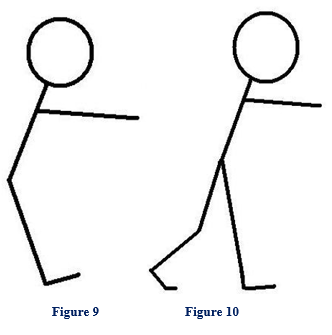
Balance reactions create time in which the shift of weight take place.
That shift must be complete because otherwise is the other leg not free and arises there the first problem to make an good step-strategy.
That free leg - step-strategy - must go far to the back.
The movement of the trunk/hip determinate the movement of the free leg. And this will be more extreme when the selectivity is lower.
Trunk/ hip- movements determinate the movements of the free leg !!
- Trunk/hip to the front, the free leg goes back.
- Trunk/hip to the back, the free leg goes to the front.
- Trunk/hip in elongation position, the free leg can cross
- Trunk/hip in shortening position, the free leg goes in abduction.
The power must be delivered through the pattern on the front side. That aren’t the strongest group but the have the capacity to react fast with an flexion in the hips/trunk and with an dorsal flexion in the feet
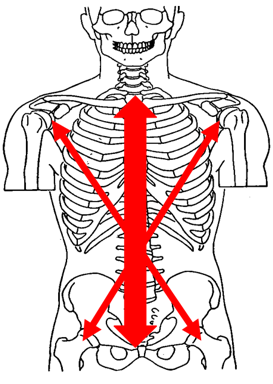
Loss of muscle power can therefore an reason that people cannot react on an disturbance in the front but still is it strange that only this would be the reason. Because an disturbance from the front is visible and by walking to the back would an relaxation of the trunk be possible.
of course an great loss of power would lead to an dominancy of the back but that is the question on his place that so many loss would inhibit all movements. Also standing up and walking.
Still this could be possible but in our belief not the most common reason. As cause we think on :
Ad.1. Loss of selectivity through loss of perception and therefore an less good input system. Awareness of movement under the foot and where the centrum of gravity exactly is.
Elderly with dementia have an perception system that often must participated with an worser input system. Till now it is this not certain what the reason is for this loss of input.
There are two possibilities and of course is there an third option that both elements are the cause :
1. Paratonia is an neurological form of tone increase as an answer of the damage brain in the cortical part. That makes that selectivity must be changed in more tone and the possibility to restrict the freedom[10] possibilities of the joint movements. But this tone increase, has an influence on the possibilities of the muscle spindles and that makes that this information is different and often far less selective. Thus tone-increase is an sign that the selectivity is lower and that the input is changed and less refined.
2. The other possibility is that the input system is of an lower quality. All senses are lesser and especially the movement feeling (discrimination-sense[10]) and recognition of the quality of the support ( gnostic sense[11]) are less by all elderly. But there is an rare element that especially elderly with dementia that are dependent in their movements, learned of this assistance and that changed the perception of the body. And that cognitive impairment has an influence on the body perception in the lying position in bed [12]. This will also occur in sit and standing position but there is no investigation on that area. Still there are signals that people that have assistance by the transfers that this changed their body perception in standing position. With support behind gave this people an signal that standing oblique to the back was in their perception right and the position right in our eye gave the feeling that they are falling to the front. The consequences of this changing of the body perception is that the balance reaction to the back get the signal in the brain later, even behind the heel and that will have an devastating result because everyone start to late.
Ad.2. Loss of selectivity through an pathological tone. By people with dementia is that paratonia.
This pathological tone is the answer of the damaged brain to control the movement through the synergies. But this synergies are movement pattern with an restricted amount of freedom degrees and that this means that selectivity is restricted.
The most important synergy for the balance is standing performance therefore the extension synergy.
That means that in the hip the tone of extension, endorotation and adduction is dominant. In the knee is that the extension.
And in the foot/ankle plantar flexion with inversion.
The muscle that take care for this synergy are the muscle that has the lowest selectivity and can work on the joint.
The adduction and endorotation of the hip will have an great impact but is necessary because this muscle can act for the hip and knee as an extensor and that is important because the selective extensor of hip and knee are not an part of the synergy pattern.
The feet are through this synergy vulnerable and asked for stability through shoes.
But the muscles that can place the hip in several positions, are through the dominancy of the muscles in the synergy inhibit.[17] Of course dependent of the loss of brain areas cortical.
The muscle that capable are for the great diversity, losses that power through the reciprocal inhibition of the dominancy of the muscle synergy pattern.
That means that walking with an straight spine and/or with an normal hip- and knee extension, because the synergy muscle pattern pull the leg in an adduction /endorotation with flexion in the hip and that count also for the knee.
This process is starting when the paratonia occur and will inhibit the speed that is necessary for an goof balance reaction.
One of the symptoms are that this person has difficult to walk straight because the hip extensor isn’t
so active anymore and this extension is done through the adductor muscle group.
When we see that knees are going to each other is that an sign that the synergy is dominant but in the time therefore is this paratonia present and asked much from that person.
The presence of paratonia and the synergy has for that person indirect the consequence that the trunk is often in an flexion position but with an great stiffness though the paratonia but also as an reaction on the synergy formation in the legs and that explains the immobility of the trunk that we say by people that walk backward as in the pictures 1-6.
Ad.3. Last part is that body perception to move sideways is changed and that this inhibit that the weight comes total on one leg.
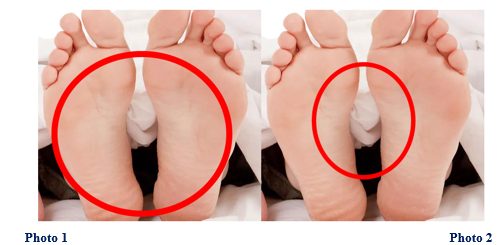
Summary
Why is backward falling the most common fall by elderly and special elderly that live in long care facility or nursing home?
1. An great part of this people suffer from neurological diseases and that means that often the tone is pathological increase and makes balance difficult, but that higher tone is not alone present in the limb but also in the trunk and neck. The relaxation of the trunk muscles is almost impossible and replace this with an flexion in the hip is also difficult because here act the adductors as extensors.
2. But without an high pathological tone, elderly will often must have an higher normal tone in the spine to hold the trunk as erect as possible and that asked extra time to release that tone.
3. The perception is often changed through the caution and also walking with an aid as the rollator frame. The movement of the hip over the foot and under foot an restricted movement to the lateral. But by backward falling [18]is an extra perception deficit discovered but this is still an hypothetical why this occur. Elderly that walk backward and fall, let us every time the same process seen. Often three or four steps to the back, we see that the trunk is over the border of the back side of the heel. The strangest element is that this person give no balance reactions, not in the feet and not in the trunk. That whole balance reaction start much too late to give an proper step strategy, with as extra problem the stiffness of the trunk. The hypothetical part is why this balance reaction start to late.
Treatment or better slowing down this process!
1. Important is that the process of losing the perception of the body.
That means that there must be assessment what the possibilities are at that moment. That include the distal information senses as also the whole body perception through the use of the statiek technique. [19,20,21,23]. In the treatment-plan must that have an place from the day that especially standing up is difficult. Standing up by elderly is often done with using of the power of the arms. But when this power is required asked this for an upper trunk backward [6] and that will start the tonus increase in the back diagonals and makes this part of the trunk often more stiff. When this is the only way people can coming to stand and often accompanied with an assistance that stimulated this movement, will this further create only more stiffness and tonus increase in the upper trunk backward.
The lack of variation is one of the reason that the body perception changed and through the problem of the standing is the upper trunk always behind the feet and see we in the first period that the brain recognized that the balance isn’t good. After an period this signal is gone and that signal- dorsal flexion- is than active when the this people are falling and then there is not enough time to react.
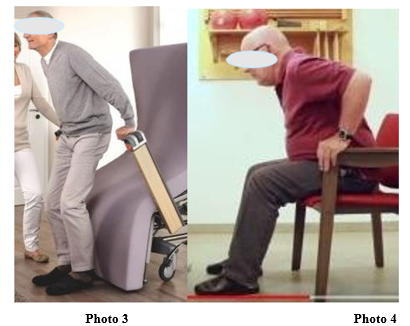
When the push of the arms is dominant than will the placing of the feet often not totally occur. That because normal we flex in the hip to the front and without weight on the foot they were placed, where the belong.
But pushing with the arms or assistance on the arm stop this movement to early and that create an new learning moment in the brain but also an loss of independency
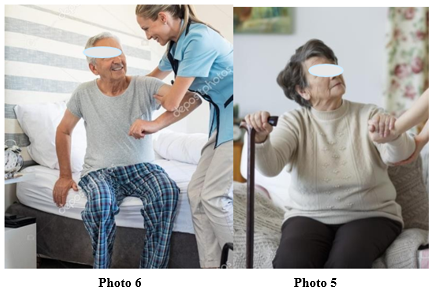
2. Mobility.
Restriction in the movement and especially in the joints are for elderly always an extra problem that asked for an adaptation. Back ward walking with an restriction in the trunk or/and the hips will asked much more from that person to hold the balance when he is walking backward. But despite this great problem, will elderly copy with this problem except when the perception and the tone are not normal.

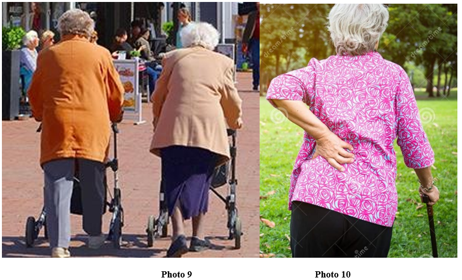
3. Tonus hyper tonus of paratonia.
The tone is often not so high and when we assess than is this by an speed that we use by the measurement of the Mas-P according the Asworth scale. [27,28]
Often is the test on the arm elbow in sitting position normal. But that isn’t equal with the tone that people need to hold the standing position and walking /balance. There fore is it important to test also with more speed [28] and feel or the resistance changed. Test also the knee and feet movements.
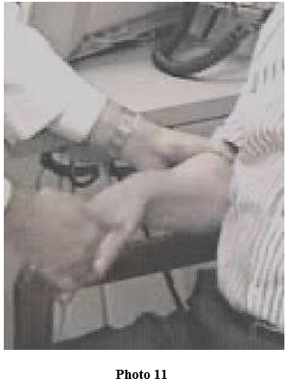
When people are capable to walk and stand but have an slow balance reaction, than can an tone increase be an reason why the weight shift is an problem because this asked speed.
Is the test done with an tone that is zero or there is doubt or this tone is really zero, than increase the speed according the Tardieu scale [28]
When than an resistance occur than can this one of the reason why the balance is an problem.
Tone increase in the leg and arms will also an sign that the tone in the trunk is increase and that the synergy ( pathological ) has some dominancy. That means that this pattern will act dominant and that will make that the weight shift lateral is almost impossible and this group will walk with an rollator frame with an upper trunk sideway and with legs in adduction and endorotation.
There is another way to measure the tone and that is the Myotron-Pro. But the only prove we till today is that we measure the tone in stillness and not know what will occur when the speed increase. This last part will be an item that is important to assess by balance problems and also the symptoms occur by lot of people before the diagnosis Dementia is set. [30]
Important that the tone of the trunk muscle can we measured. That can we do in an sitting position through the placing technique [31]. Place your hand on the shoulder an give with the hand and verbal instruction that the person must flex the trunk so fast as possible an so far as possible. This cost some time but the reaction must be equal or faster that the time used in the Asworth scale.
This is often almost impossible because think everyone the mobility isn’t present.
Than test the mobility and tone after an period of rest lying on the back and then is often the relaxation present and is the movement easy.
Do the test than again but than in sitting position and often is than there all an difference and that is the pathological tone -paratonia or rigidity.
Especially the low tone differences that we assessed when we increase the speed, is the brace that the pathological tone will give by “fast “movements.
And this will also increase the tone of the trunk and an loss of selectivity in arms and legs but in an resting situation will nobody see what photo 13 let see.
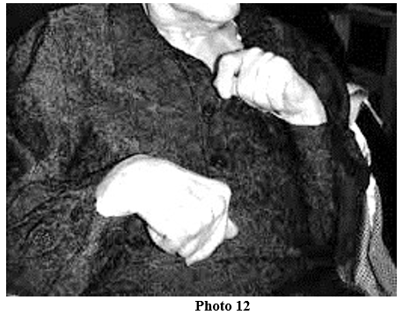

3. Shoulder position, compared this by the lady and by the gentlemen. The lady let the shoulder “hang” and there isn’t an high tone of the scapula. By the gentlemen is the opposite, no relaxation but together with tone increase of the trunk the shoulder blade are standing in retraction and this give in the gleno-humeral joint retroflexion and in the elbow an flexion. Sign that the tone is high in the trunk from cervical -thoracal -lumbar and this isn’t an “normal” high tone but here is an pathological tone active, necessary to hold control. Here we see the stiffness in the trunk that is so characteristic by backward falling.
4. The position of the hip and knee are signs that the legs must correct the attitude to hold the balance in this case not to fall to the back. And the lady is full in action on the end of their balance to the back. The white line let see how much of the body is for and back and the difference is great.
5. Feet action in by the gentlemen only an plantar flexion, maybe clawing in the toes and the exercise
was : “ Go so far as possible to the back”, this is the translation of the gentlemen.
The lady is on that endpoint and that seen we on the dorsal flexion in the feet.
6. Looking to the performance together with the white line gives an clear picture what the problems are of the gentlemen. That is the high tone that makes it for him impossible to control the trunk despite the adaptation in the leg but the tone in the upper trunk is so high to brace the fall to the front and then is searching for an balance to the back very difficult and asked everything of the body perception because the tone will only increase.
The stretch on the muscles in the front part of the neck is high and that can together with the high tone give problems with eating and swallowing.[33]
4. Movement training walking and trunk /hip bending.
Often the moment that tone interfere with smoothly of the movements, is the moment that an walking aid or balance aid is necessary. Often is that the rollator frame and one of the greatest advance of this device that the necessity of an higher tone isn’t present.
But this device will decrease the power and coordination of the lower trunk and legs and almost always the lateral movement of the hip over the foot. That will change the perception and also the power that is present in the muscles around the hip.
The arms take an lot over but one of the movements that people not make, walking with an rollator frame, is bending through the arms and make more flexion in the trunk.
The moment that support is increasing on the arms the decrease of power and coordination in the legs go fast and this will increase the stiffness of the trunk.
This knowing must there an training program pointed on walking with an rollator in all direction and backward always with an more bending trunk.
Training of balance is of course important but when the tone is above Mas-P 1 than has this only useful when we can lowering the tone to get the necessary selectivity and that can only when the gravity is lowering (see point 7)
Training of the coordination and power must be done by task specific resistance training, that will give the best transfer and slow down the process.
Here we must care that the difficulty isn’t too high because that increase the tone.
We want movement against resistance within the possibilities of the person that increase the power and coordination.
We can this also do with walking behind an chair with resistance.
Pushing an chair with weight will change the posture totally from the attitude that people take when the walk behind the rollator frame.
The difference is that an chair with weight asked for an pushing action and walking with an rollator frame asked for an support on the handles to decrease the weight and coordination of the lower trunk and the legs.
Therefore pushing an chair is an treatment to slow the process.
Resistance as photo 14 can be given in all directions, therefore with great variation and stimulated the standing leg to give stability and movement to sway the swing leg.
Bending the trunk and hip is possible with that chair but with much more attributes. With the chair is simple turning the chair and walk with this with an bending trunk. But to learn how the trunk to relax can be done by bending to the sit part, but also through lifting the chair of the floor and then placing and walking with the hands on the side support or even the sitting. of course is relaxation in sit and lying position also possible but the gravity is standing position is essential to get the feeling what relaxation is. Still this tone is an pathological tone and relaxation isn’t easy, stretch but also activation can give an decrease but also lowering of the gravity.
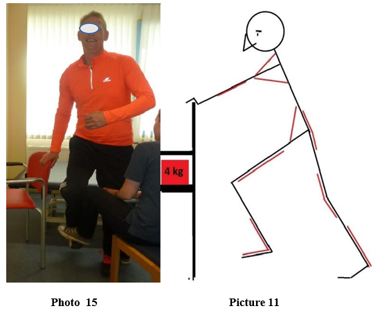
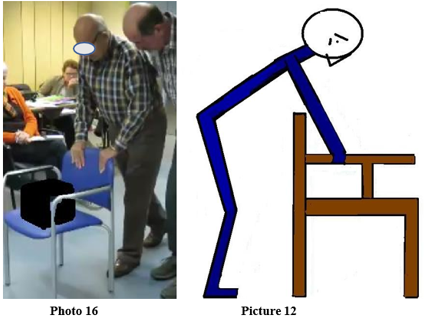
Pushing will activated an difference muscle pattern to get enough power from the trunk/legs to tha arms and get the chair in movement. Use load and calculated what the distance must be, how much rehearsal and the weekly frequency.
Muscle fatigue is an essential muscle stimulus to get an improving of the power and coordination of this muscle system.
5. Kneeling and standing up.
Elderly are afraid for falling but the reason isn’t only the pain but also the fact that the are afraid that
they are not capable to stand up and that they lie for hours on the floor.
This kneeling down or losing the back can be done when the person support himself with the hands/arms and legs, than is movements between this two point possible and that can decrease the tone and stiffness of the trunk.

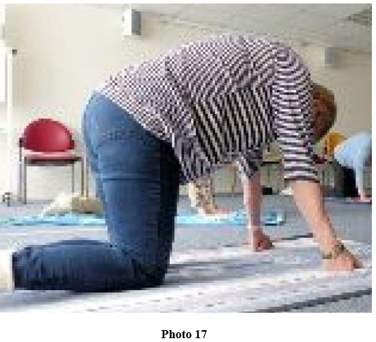
That there are changing in the tone, in the muscle itself [33,34], in the joint of the spine but also the shoulder and hip is certain and all have influence on the tone and stiffness.
Prevention of backward falling will never be possible for everyone, but though the treatment will there be an lowering of the danger and the occurrence.
6. Perception under the whole foot.
Till today is by neurological diseases little effect found by training of the disturbed perception [35]. This comparing with the motoric approach was the conclusion that the motoric approach has an better effect also on the restoration of some body perception (total and local). At this moment is the activity the best perception treatment but by elderly with dementia is also damage in the cortical projections. The motoric performance will be alter through the tone and that will also have an influence on the body perception. Or is an lower perception the reason that the damaged brain seek for an solution and is that the use of pathological synergy with paratonia.
When we task specific resistance training apply with load will this also stimulated the perception of the body through the load will this give more body information in the brain.
Other alternative is water that gives through the hairs much more information that can influence the perception projection in the brain and that with an decrease tone.
7. Hydrotherapy.
The combination of the stiffness in the trunk/hip through the high tone and/or pathological tone (paratonia) and the restricted or even wrong body perception asked for an situation that can solve some of the problems.
Hydrotherapy can solve an few problems and create an environment that stimulated movement. This because moving in water give people an surrounding that support them and will brace the falls but has also an positive effect on the tone because the gravity is reduced [36].
This all together with an good program of balance training will give elderly with and without dementia the possibility to control the trunk/hip movement/mobility and will there help the weight bearing increase over the whole feet and will inhibit the “wrong “perception that we say when elderly start their balance to the back when the weight is passed the heel.
Backward falling is dangerous but on the other hand often present after an few steps to the back and can lead to trauma from legs, spine to the head.
Robinovitch team show that this occur the most in long car facilities and that this also occur with an walking aid.
We investigated what the reasons could be that caused this incapacity to walk back and not control the balance properly. This reasons were often and the stiffness of the trunk/hip and the body perception.
The awareness where the body is in totally but also where the weight on the feet were. By back ward falling was remarkable that the reaction occur often too late. When the weight was behind the heel than the reaction get starting and that is too late.
Further was the stiffness in the trunk/hip often high and was the reaction of the trunk to the front slow and that makes an step strategy no chance also because the trunk movement to the front facilitated the free leg to the back.
Still there are possibilities to slow down this process by an treatment that take care for trunk mobility and train the correct movement with an good perception.
Clearly Auctoresonline and particularly Psychology and Mental Health Care Journal is dedicated to improving health care services for individuals and populations. The editorial boards' ability to efficiently recognize and share the global importance of health literacy with a variety of stakeholders. Auctoresonline publishing platform can be used to facilitate of optimal client-based services and should be added to health care professionals' repertoire of evidence-based health care resources.

Journal of Clinical Cardiology and Cardiovascular Intervention The submission and review process was adequate. However I think that the publication total value should have been enlightened in early fases. Thank you for all.

Journal of Women Health Care and Issues By the present mail, I want to say thank to you and tour colleagues for facilitating my published article. Specially thank you for the peer review process, support from the editorial office. I appreciate positively the quality of your journal.
Journal of Clinical Research and Reports I would be very delighted to submit my testimonial regarding the reviewer board and the editorial office. The reviewer board were accurate and helpful regarding any modifications for my manuscript. And the editorial office were very helpful and supportive in contacting and monitoring with any update and offering help. It was my pleasure to contribute with your promising Journal and I am looking forward for more collaboration.

We would like to thank the Journal of Thoracic Disease and Cardiothoracic Surgery because of the services they provided us for our articles. The peer-review process was done in a very excellent time manner, and the opinions of the reviewers helped us to improve our manuscript further. The editorial office had an outstanding correspondence with us and guided us in many ways. During a hard time of the pandemic that is affecting every one of us tremendously, the editorial office helped us make everything easier for publishing scientific work. Hope for a more scientific relationship with your Journal.

The peer-review process which consisted high quality queries on the paper. I did answer six reviewers’ questions and comments before the paper was accepted. The support from the editorial office is excellent.

Journal of Neuroscience and Neurological Surgery. I had the experience of publishing a research article recently. The whole process was simple from submission to publication. The reviewers made specific and valuable recommendations and corrections that improved the quality of my publication. I strongly recommend this Journal.

Dr. Katarzyna Byczkowska My testimonial covering: "The peer review process is quick and effective. The support from the editorial office is very professional and friendly. Quality of the Clinical Cardiology and Cardiovascular Interventions is scientific and publishes ground-breaking research on cardiology that is useful for other professionals in the field.

Thank you most sincerely, with regard to the support you have given in relation to the reviewing process and the processing of my article entitled "Large Cell Neuroendocrine Carcinoma of The Prostate Gland: A Review and Update" for publication in your esteemed Journal, Journal of Cancer Research and Cellular Therapeutics". The editorial team has been very supportive.

Testimony of Journal of Clinical Otorhinolaryngology: work with your Reviews has been a educational and constructive experience. The editorial office were very helpful and supportive. It was a pleasure to contribute to your Journal.

Dr. Bernard Terkimbi Utoo, I am happy to publish my scientific work in Journal of Women Health Care and Issues (JWHCI). The manuscript submission was seamless and peer review process was top notch. I was amazed that 4 reviewers worked on the manuscript which made it a highly technical, standard and excellent quality paper. I appreciate the format and consideration for the APC as well as the speed of publication. It is my pleasure to continue with this scientific relationship with the esteem JWHCI.

This is an acknowledgment for peer reviewers, editorial board of Journal of Clinical Research and Reports. They show a lot of consideration for us as publishers for our research article “Evaluation of the different factors associated with side effects of COVID-19 vaccination on medical students, Mutah university, Al-Karak, Jordan”, in a very professional and easy way. This journal is one of outstanding medical journal.
Dear Hao Jiang, to Journal of Nutrition and Food Processing We greatly appreciate the efficient, professional and rapid processing of our paper by your team. If there is anything else we should do, please do not hesitate to let us know. On behalf of my co-authors, we would like to express our great appreciation to editor and reviewers.

As an author who has recently published in the journal "Brain and Neurological Disorders". I am delighted to provide a testimonial on the peer review process, editorial office support, and the overall quality of the journal. The peer review process at Brain and Neurological Disorders is rigorous and meticulous, ensuring that only high-quality, evidence-based research is published. The reviewers are experts in their fields, and their comments and suggestions were constructive and helped improve the quality of my manuscript. The review process was timely and efficient, with clear communication from the editorial office at each stage. The support from the editorial office was exceptional throughout the entire process. The editorial staff was responsive, professional, and always willing to help. They provided valuable guidance on formatting, structure, and ethical considerations, making the submission process seamless. Moreover, they kept me informed about the status of my manuscript and provided timely updates, which made the process less stressful. The journal Brain and Neurological Disorders is of the highest quality, with a strong focus on publishing cutting-edge research in the field of neurology. The articles published in this journal are well-researched, rigorously peer-reviewed, and written by experts in the field. The journal maintains high standards, ensuring that readers are provided with the most up-to-date and reliable information on brain and neurological disorders. In conclusion, I had a wonderful experience publishing in Brain and Neurological Disorders. The peer review process was thorough, the editorial office provided exceptional support, and the journal's quality is second to none. I would highly recommend this journal to any researcher working in the field of neurology and brain disorders.

Dear Agrippa Hilda, Journal of Neuroscience and Neurological Surgery, Editorial Coordinator, I trust this message finds you well. I want to extend my appreciation for considering my article for publication in your esteemed journal. I am pleased to provide a testimonial regarding the peer review process and the support received from your editorial office. The peer review process for my paper was carried out in a highly professional and thorough manner. The feedback and comments provided by the authors were constructive and very useful in improving the quality of the manuscript. This rigorous assessment process undoubtedly contributes to the high standards maintained by your journal.

International Journal of Clinical Case Reports and Reviews. I strongly recommend to consider submitting your work to this high-quality journal. The support and availability of the Editorial staff is outstanding and the review process was both efficient and rigorous.

Thank you very much for publishing my Research Article titled “Comparing Treatment Outcome Of Allergic Rhinitis Patients After Using Fluticasone Nasal Spray And Nasal Douching" in the Journal of Clinical Otorhinolaryngology. As Medical Professionals we are immensely benefited from study of various informative Articles and Papers published in this high quality Journal. I look forward to enriching my knowledge by regular study of the Journal and contribute my future work in the field of ENT through the Journal for use by the medical fraternity. The support from the Editorial office was excellent and very prompt. I also welcome the comments received from the readers of my Research Article.

Dear Erica Kelsey, Editorial Coordinator of Cancer Research and Cellular Therapeutics Our team is very satisfied with the processing of our paper by your journal. That was fast, efficient, rigorous, but without unnecessary complications. We appreciated the very short time between the submission of the paper and its publication on line on your site.

I am very glad to say that the peer review process is very successful and fast and support from the Editorial Office. Therefore, I would like to continue our scientific relationship for a long time. And I especially thank you for your kindly attention towards my article. Have a good day!

"We recently published an article entitled “Influence of beta-Cyclodextrins upon the Degradation of Carbofuran Derivatives under Alkaline Conditions" in the Journal of “Pesticides and Biofertilizers” to show that the cyclodextrins protect the carbamates increasing their half-life time in the presence of basic conditions This will be very helpful to understand carbofuran behaviour in the analytical, agro-environmental and food areas. We greatly appreciated the interaction with the editor and the editorial team; we were particularly well accompanied during the course of the revision process, since all various steps towards publication were short and without delay".

I would like to express my gratitude towards you process of article review and submission. I found this to be very fair and expedient. Your follow up has been excellent. I have many publications in national and international journal and your process has been one of the best so far. Keep up the great work.

We are grateful for this opportunity to provide a glowing recommendation to the Journal of Psychiatry and Psychotherapy. We found that the editorial team were very supportive, helpful, kept us abreast of timelines and over all very professional in nature. The peer review process was rigorous, efficient and constructive that really enhanced our article submission. The experience with this journal remains one of our best ever and we look forward to providing future submissions in the near future.

I am very pleased to serve as EBM of the journal, I hope many years of my experience in stem cells can help the journal from one way or another. As we know, stem cells hold great potential for regenerative medicine, which are mostly used to promote the repair response of diseased, dysfunctional or injured tissue using stem cells or their derivatives. I think Stem Cell Research and Therapeutics International is a great platform to publish and share the understanding towards the biology and translational or clinical application of stem cells.

I would like to give my testimony in the support I have got by the peer review process and to support the editorial office where they were of asset to support young author like me to be encouraged to publish their work in your respected journal and globalize and share knowledge across the globe. I really give my great gratitude to your journal and the peer review including the editorial office.

I am delighted to publish our manuscript entitled "A Perspective on Cocaine Induced Stroke - Its Mechanisms and Management" in the Journal of Neuroscience and Neurological Surgery. The peer review process, support from the editorial office, and quality of the journal are excellent. The manuscripts published are of high quality and of excellent scientific value. I recommend this journal very much to colleagues.

Dr.Tania Muñoz, My experience as researcher and author of a review article in The Journal Clinical Cardiology and Interventions has been very enriching and stimulating. The editorial team is excellent, performs its work with absolute responsibility and delivery. They are proactive, dynamic and receptive to all proposals. Supporting at all times the vast universe of authors who choose them as an option for publication. The team of review specialists, members of the editorial board, are brilliant professionals, with remarkable performance in medical research and scientific methodology. Together they form a frontline team that consolidates the JCCI as a magnificent option for the publication and review of high-level medical articles and broad collective interest. I am honored to be able to share my review article and open to receive all your comments.

“The peer review process of JPMHC is quick and effective. Authors are benefited by good and professional reviewers with huge experience in the field of psychology and mental health. The support from the editorial office is very professional. People to contact to are friendly and happy to help and assist any query authors might have. Quality of the Journal is scientific and publishes ground-breaking research on mental health that is useful for other professionals in the field”.

Dear editorial department: On behalf of our team, I hereby certify the reliability and superiority of the International Journal of Clinical Case Reports and Reviews in the peer review process, editorial support, and journal quality. Firstly, the peer review process of the International Journal of Clinical Case Reports and Reviews is rigorous, fair, transparent, fast, and of high quality. The editorial department invites experts from relevant fields as anonymous reviewers to review all submitted manuscripts. These experts have rich academic backgrounds and experience, and can accurately evaluate the academic quality, originality, and suitability of manuscripts. The editorial department is committed to ensuring the rigor of the peer review process, while also making every effort to ensure a fast review cycle to meet the needs of authors and the academic community. Secondly, the editorial team of the International Journal of Clinical Case Reports and Reviews is composed of a group of senior scholars and professionals with rich experience and professional knowledge in related fields. The editorial department is committed to assisting authors in improving their manuscripts, ensuring their academic accuracy, clarity, and completeness. Editors actively collaborate with authors, providing useful suggestions and feedback to promote the improvement and development of the manuscript. We believe that the support of the editorial department is one of the key factors in ensuring the quality of the journal. Finally, the International Journal of Clinical Case Reports and Reviews is renowned for its high- quality articles and strict academic standards. The editorial department is committed to publishing innovative and academically valuable research results to promote the development and progress of related fields. The International Journal of Clinical Case Reports and Reviews is reasonably priced and ensures excellent service and quality ratio, allowing authors to obtain high-level academic publishing opportunities in an affordable manner. I hereby solemnly declare that the International Journal of Clinical Case Reports and Reviews has a high level of credibility and superiority in terms of peer review process, editorial support, reasonable fees, and journal quality. Sincerely, Rui Tao.

Clinical Cardiology and Cardiovascular Interventions I testity the covering of the peer review process, support from the editorial office, and quality of the journal.

Clinical Cardiology and Cardiovascular Interventions, we deeply appreciate the interest shown in our work and its publication. It has been a true pleasure to collaborate with you. The peer review process, as well as the support provided by the editorial office, have been exceptional, and the quality of the journal is very high, which was a determining factor in our decision to publish with you.
The peer reviewers process is quick and effective, the supports from editorial office is excellent, the quality of journal is high. I would like to collabroate with Internatioanl journal of Clinical Case Reports and Reviews journal clinically in the future time.

Clinical Cardiology and Cardiovascular Interventions, I would like to express my sincerest gratitude for the trust placed in our team for the publication in your journal. It has been a true pleasure to collaborate with you on this project. I am pleased to inform you that both the peer review process and the attention from the editorial coordination have been excellent. Your team has worked with dedication and professionalism to ensure that your publication meets the highest standards of quality. We are confident that this collaboration will result in mutual success, and we are eager to see the fruits of this shared effort.

Dear Dr. Jessica Magne, Editorial Coordinator 0f Clinical Cardiology and Cardiovascular Interventions, I hope this message finds you well. I want to express my utmost gratitude for your excellent work and for the dedication and speed in the publication process of my article titled "Navigating Innovation: Qualitative Insights on Using Technology for Health Education in Acute Coronary Syndrome Patients." I am very satisfied with the peer review process, the support from the editorial office, and the quality of the journal. I hope we can maintain our scientific relationship in the long term.
Dear Monica Gissare, - Editorial Coordinator of Nutrition and Food Processing. ¨My testimony with you is truly professional, with a positive response regarding the follow-up of the article and its review, you took into account my qualities and the importance of the topic¨.

Dear Dr. Jessica Magne, Editorial Coordinator 0f Clinical Cardiology and Cardiovascular Interventions, The review process for the article “The Handling of Anti-aggregants and Anticoagulants in the Oncologic Heart Patient Submitted to Surgery” was extremely rigorous and detailed. From the initial submission to the final acceptance, the editorial team at the “Journal of Clinical Cardiology and Cardiovascular Interventions” demonstrated a high level of professionalism and dedication. The reviewers provided constructive and detailed feedback, which was essential for improving the quality of our work. Communication was always clear and efficient, ensuring that all our questions were promptly addressed. The quality of the “Journal of Clinical Cardiology and Cardiovascular Interventions” is undeniable. It is a peer-reviewed, open-access publication dedicated exclusively to disseminating high-quality research in the field of clinical cardiology and cardiovascular interventions. The journal's impact factor is currently under evaluation, and it is indexed in reputable databases, which further reinforces its credibility and relevance in the scientific field. I highly recommend this journal to researchers looking for a reputable platform to publish their studies.

Dear Editorial Coordinator of the Journal of Nutrition and Food Processing! "I would like to thank the Journal of Nutrition and Food Processing for including and publishing my article. The peer review process was very quick, movement and precise. The Editorial Board has done an extremely conscientious job with much help, valuable comments and advices. I find the journal very valuable from a professional point of view, thank you very much for allowing me to be part of it and I would like to participate in the future!”

Dealing with The Journal of Neurology and Neurological Surgery was very smooth and comprehensive. The office staff took time to address my needs and the response from editors and the office was prompt and fair. I certainly hope to publish with this journal again.Their professionalism is apparent and more than satisfactory. Susan Weiner

My Testimonial Covering as fellowing: Lin-Show Chin. The peer reviewers process is quick and effective, the supports from editorial office is excellent, the quality of journal is high. I would like to collabroate with Internatioanl journal of Clinical Case Reports and Reviews.

My experience publishing in Psychology and Mental Health Care was exceptional. The peer review process was rigorous and constructive, with reviewers providing valuable insights that helped enhance the quality of our work. The editorial team was highly supportive and responsive, making the submission process smooth and efficient. The journal's commitment to high standards and academic rigor makes it a respected platform for quality research. I am grateful for the opportunity to publish in such a reputable journal.
My experience publishing in International Journal of Clinical Case Reports and Reviews was exceptional. I Come forth to Provide a Testimonial Covering the Peer Review Process and the editorial office for the Professional and Impartial Evaluation of the Manuscript.

I would like to offer my testimony in the support. I have received through the peer review process and support the editorial office where they are to support young authors like me, encourage them to publish their work in your esteemed journals, and globalize and share knowledge globally. I really appreciate your journal, peer review, and editorial office.
Dear Agrippa Hilda- Editorial Coordinator of Journal of Neuroscience and Neurological Surgery, "The peer review process was very quick and of high quality, which can also be seen in the articles in the journal. The collaboration with the editorial office was very good."

I would like to express my sincere gratitude for the support and efficiency provided by the editorial office throughout the publication process of my article, “Delayed Vulvar Metastases from Rectal Carcinoma: A Case Report.” I greatly appreciate the assistance and guidance I received from your team, which made the entire process smooth and efficient. The peer review process was thorough and constructive, contributing to the overall quality of the final article. I am very grateful for the high level of professionalism and commitment shown by the editorial staff, and I look forward to maintaining a long-term collaboration with the International Journal of Clinical Case Reports and Reviews.
To Dear Erin Aust, I would like to express my heartfelt appreciation for the opportunity to have my work published in this esteemed journal. The entire publication process was smooth and well-organized, and I am extremely satisfied with the final result. The Editorial Team demonstrated the utmost professionalism, providing prompt and insightful feedback throughout the review process. Their clear communication and constructive suggestions were invaluable in enhancing my manuscript, and their meticulous attention to detail and dedication to quality are truly commendable. Additionally, the support from the Editorial Office was exceptional. From the initial submission to the final publication, I was guided through every step of the process with great care and professionalism. The team's responsiveness and assistance made the entire experience both easy and stress-free. I am also deeply impressed by the quality and reputation of the journal. It is an honor to have my research featured in such a respected publication, and I am confident that it will make a meaningful contribution to the field.

"I am grateful for the opportunity of contributing to [International Journal of Clinical Case Reports and Reviews] and for the rigorous review process that enhances the quality of research published in your esteemed journal. I sincerely appreciate the time and effort of your team who have dedicatedly helped me in improvising changes and modifying my manuscript. The insightful comments and constructive feedback provided have been invaluable in refining and strengthening my work".

I thank the ‘Journal of Clinical Research and Reports’ for accepting this article for publication. This is a rigorously peer reviewed journal which is on all major global scientific data bases. I note the review process was prompt, thorough and professionally critical. It gave us an insight into a number of important scientific/statistical issues. The review prompted us to review the relevant literature again and look at the limitations of the study. The peer reviewers were open, clear in the instructions and the editorial team was very prompt in their communication. This journal certainly publishes quality research articles. I would recommend the journal for any future publications.

Dear Jessica Magne, with gratitude for the joint work. Fast process of receiving and processing the submitted scientific materials in “Clinical Cardiology and Cardiovascular Interventions”. High level of competence of the editors with clear and correct recommendations and ideas for enriching the article.

We found the peer review process quick and positive in its input. The support from the editorial officer has been very agile, always with the intention of improving the article and taking into account our subsequent corrections.

My article, titled 'No Way Out of the Smartphone Epidemic Without Considering the Insights of Brain Research,' has been republished in the International Journal of Clinical Case Reports and Reviews. The review process was seamless and professional, with the editors being both friendly and supportive. I am deeply grateful for their efforts.
To Dear Erin Aust – Editorial Coordinator of Journal of General Medicine and Clinical Practice! I declare that I am absolutely satisfied with your work carried out with great competence in following the manuscript during the various stages from its receipt, during the revision process to the final acceptance for publication. Thank Prof. Elvira Farina

Dear Jessica, and the super professional team of the ‘Clinical Cardiology and Cardiovascular Interventions’ I am sincerely grateful to the coordinated work of the journal team for the no problem with the submission of my manuscript: “Cardiometabolic Disorders in A Pregnant Woman with Severe Preeclampsia on the Background of Morbid Obesity (Case Report).” The review process by 5 experts was fast, and the comments were professional, which made it more specific and academic, and the process of publication and presentation of the article was excellent. I recommend that my colleagues publish articles in this journal, and I am interested in further scientific cooperation. Sincerely and best wishes, Dr. Oleg Golyanovskiy.

Dear Ashley Rosa, Editorial Coordinator of the journal - Psychology and Mental Health Care. " The process of obtaining publication of my article in the Psychology and Mental Health Journal was positive in all areas. The peer review process resulted in a number of valuable comments, the editorial process was collaborative and timely, and the quality of this journal has been quickly noticed, resulting in alternative journals contacting me to publish with them." Warm regards, Susan Anne Smith, PhD. Australian Breastfeeding Association.

Dear Jessica Magne, Editorial Coordinator, Clinical Cardiology and Cardiovascular Interventions, Auctores Publishing LLC. I appreciate the journal (JCCI) editorial office support, the entire team leads were always ready to help, not only on technical front but also on thorough process. Also, I should thank dear reviewers’ attention to detail and creative approach to teach me and bring new insights by their comments. Surely, more discussions and introduction of other hemodynamic devices would provide better prevention and management of shock states. Your efforts and dedication in presenting educational materials in this journal are commendable. Best wishes from, Farahnaz Fallahian.
Dear Maria Emerson, Editorial Coordinator, International Journal of Clinical Case Reports and Reviews, Auctores Publishing LLC. I am delighted to have published our manuscript, "Acute Colonic Pseudo-Obstruction (ACPO): A rare but serious complication following caesarean section." I want to thank the editorial team, especially Maria Emerson, for their prompt review of the manuscript, quick responses to queries, and overall support. Yours sincerely Dr. Victor Olagundoye.

Dear Ashley Rosa, Editorial Coordinator, International Journal of Clinical Case Reports and Reviews. Many thanks for publishing this manuscript after I lost confidence the editors were most helpful, more than other journals Best wishes from, Susan Anne Smith, PhD. Australian Breastfeeding Association.

Dear Agrippa Hilda, Editorial Coordinator, Journal of Neuroscience and Neurological Surgery. The entire process including article submission, review, revision, and publication was extremely easy. The journal editor was prompt and helpful, and the reviewers contributed to the quality of the paper. Thank you so much! Eric Nussbaum, MD
Dr Hala Al Shaikh This is to acknowledge that the peer review process for the article ’ A Novel Gnrh1 Gene Mutation in Four Omani Male Siblings, Presentation and Management ’ sent to the International Journal of Clinical Case Reports and Reviews was quick and smooth. The editorial office was prompt with easy communication.

Dear Erin Aust, Editorial Coordinator, Journal of General Medicine and Clinical Practice. We are pleased to share our experience with the “Journal of General Medicine and Clinical Practice”, following the successful publication of our article. The peer review process was thorough and constructive, helping to improve the clarity and quality of the manuscript. We are especially thankful to Ms. Erin Aust, the Editorial Coordinator, for her prompt communication and continuous support throughout the process. Her professionalism ensured a smooth and efficient publication experience. The journal upholds high editorial standards, and we highly recommend it to fellow researchers seeking a credible platform for their work. Best wishes By, Dr. Rakhi Mishra.

Dear Jessica Magne, Editorial Coordinator, Clinical Cardiology and Cardiovascular Interventions, Auctores Publishing LLC. The peer review process of the journal of Clinical Cardiology and Cardiovascular Interventions was excellent and fast, as was the support of the editorial office and the quality of the journal. Kind regards Walter F. Riesen Prof. Dr. Dr. h.c. Walter F. Riesen.

Dear Ashley Rosa, Editorial Coordinator, International Journal of Clinical Case Reports and Reviews, Auctores Publishing LLC. Thank you for publishing our article, Exploring Clozapine's Efficacy in Managing Aggression: A Multiple Single-Case Study in Forensic Psychiatry in the international journal of clinical case reports and reviews. We found the peer review process very professional and efficient. The comments were constructive, and the whole process was efficient. On behalf of the co-authors, I would like to thank you for publishing this article. With regards, Dr. Jelle R. Lettinga.

Dear Clarissa Eric, Editorial Coordinator, Journal of Clinical Case Reports and Studies, I would like to express my deep admiration for the exceptional professionalism demonstrated by your journal. I am thoroughly impressed by the speed of the editorial process, the substantive and insightful reviews, and the meticulous preparation of the manuscript for publication. Additionally, I greatly appreciate the courteous and immediate responses from your editorial office to all my inquiries. Best Regards, Dariusz Ziora

Dear Chrystine Mejia, Editorial Coordinator, Journal of Neurodegeneration and Neurorehabilitation, Auctores Publishing LLC, We would like to thank the editorial team for the smooth and high-quality communication leading up to the publication of our article in the Journal of Neurodegeneration and Neurorehabilitation. The reviewers have extensive knowledge in the field, and their relevant questions helped to add value to our publication. Kind regards, Dr. Ravi Shrivastava.

Dear Clarissa Eric, Editorial Coordinator, Journal of Clinical Case Reports and Studies, Auctores Publishing LLC, USA Office: +1-(302)-520-2644. I would like to express my sincere appreciation for the efficient and professional handling of my case report by the ‘Journal of Clinical Case Reports and Studies’. The peer review process was not only fast but also highly constructive—the reviewers’ comments were clear, relevant, and greatly helped me improve the quality and clarity of my manuscript. I also received excellent support from the editorial office throughout the process. Communication was smooth and timely, and I felt well guided at every stage, from submission to publication. The overall quality and rigor of the journal are truly commendable. I am pleased to have published my work with Journal of Clinical Case Reports and Studies, and I look forward to future opportunities for collaboration. Sincerely, Aline Tollet, UCLouvain.

Dear Ms. Mayra Duenas, Editorial Coordinator, International Journal of Clinical Case Reports and Reviews. “The International Journal of Clinical Case Reports and Reviews represented the “ideal house” to share with the research community a first experience with the use of the Simeox device for speech rehabilitation. High scientific reputation and attractive website communication were first determinants for the selection of this Journal, and the following submission process exceeded expectations: fast but highly professional peer review, great support by the editorial office, elegant graphic layout. Exactly what a dynamic research team - also composed by allied professionals - needs!" From, Chiara Beccaluva, PT - Italy.

Dear Maria Emerson, Editorial Coordinator, we have deeply appreciated the professionalism demonstrated by the International Journal of Clinical Case Reports and Reviews. The reviewers have extensive knowledge of our field and have been very efficient and fast in supporting the process. I am really looking forward to further collaboration. Thanks. Best regards, Dr. Claudio Ligresti
Dear Chrystine Mejia, Editorial Coordinator, Journal of Neurodegeneration and Neurorehabilitation. “The peer review process was efficient and constructive, and the editorial office provided excellent communication and support throughout. The journal ensures scientific rigor and high editorial standards, while also offering a smooth and timely publication process. We sincerely appreciate the work of the editorial team in facilitating the dissemination of innovative approaches such as the Bonori Method.” Best regards, Dr. Matteo Bonori.

I recommend without hesitation submitting relevant papers on medical decision making to the International Journal of Clinical Case Reports and Reviews. I am very grateful to the editorial staff. Maria Emerson was a pleasure to communicate with. The time from submission to publication was an extremely short 3 weeks. The editorial staff submitted the paper to three reviewers. Two of the reviewers commented positively on the value of publishing the paper. The editorial staff quickly recognized the third reviewer’s comments as an unjust attempt to reject the paper. I revised the paper as recommended by the first two reviewers.

Dear Maria Emerson, Editorial Coordinator, Journal of Clinical Research and Reports. Thank you for publishing our case report: "Clinical Case of Effective Fetal Stem Cells Treatment in a Patient with Autism Spectrum Disorder" within the "Journal of Clinical Research and Reports" being submitted by the team of EmCell doctors from Kyiv, Ukraine. We much appreciate a professional and transparent peer-review process from Auctores. All research Doctors are so grateful to your Editorial Office and Auctores Publishing support! I amiably wish our article publication maintained a top quality of your International Scientific Journal. My best wishes for a prosperity of the Journal of Clinical Research and Reports. Hope our scientific relationship and cooperation will remain long lasting. Thank you very much indeed. Kind regards, Dr. Andriy Sinelnyk Cell Therapy Center EmCell
